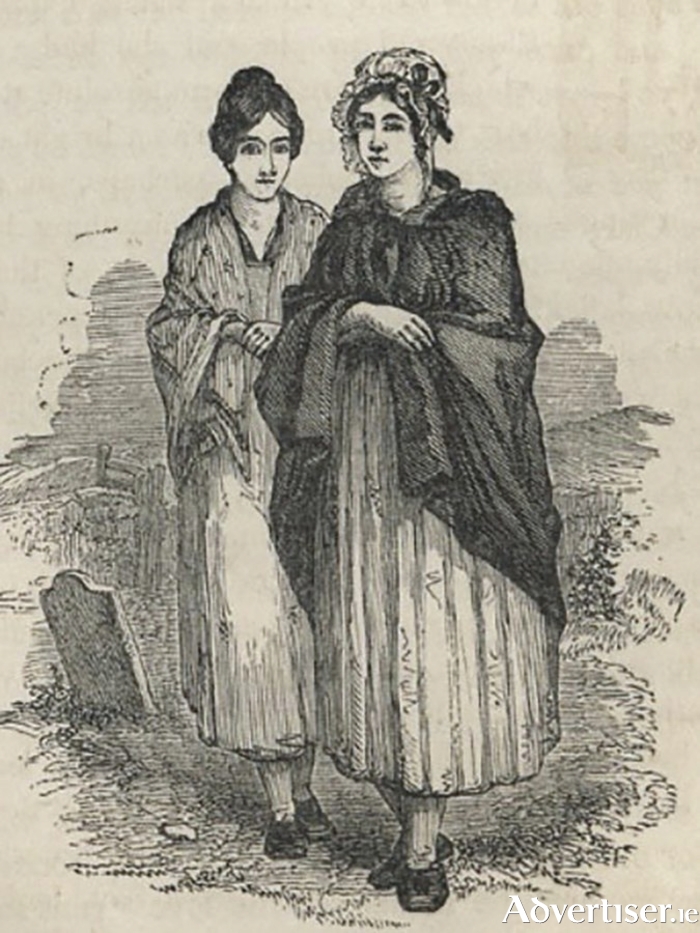Mary Sheridan was 17 years old. She was born in Westport in 1840. Her parents were dead, possibly taken by the Great Famine. At some point in late 1856, she left Westport Workhouse. She spent some time with an aunt and then took to the road, arriving at the Curragh, County Kildare, in mid-April 1857. Shortly after, she befriended Mary Moran.
On the evening of Saturday, 25 April 1857, the pair were on the roadside at Brownstown, near the Curragh Camp. Moran complained of being ill and having a sore throat. She asked Sheridan to stay with her for the night. They found a place to shelter under steps at the end of a stable. Sheridan lay down to sleep, but Moran did not — she sat with her back to the wall and legs outstretched. At about 2am, Sheridan woke. Seeing her companion still sitting up, she asked her to lie down. Moran replied that she would in a while and told Sheridan to go back to sleep. Sheridan was awoken at 8am by a boy who ordered her to leave with her companion. Moran was sitting in the same position as when they last spoke. When Sheridan put her hand on her, she knew she was dead.
An inquest followed at the police barracks, Brownstown, before the coroner, Dr Carter. The press noted: "The case excited much interest, as the deceased was known to be one of the wretched females infesting the precincts of the Curragh." Shopkeeper Mrs J Harman gave evidence that the deceased had called into her shop in Brownstown on Saturday evening and bought bread and butter. Harman recalled telling Moran that she looked ill. Moran replied that she was, adding, "I do not care if I were dead this night if the Lord had mercy on my soul." She put the bread and butter in her apron and left.
The jury found that Mary Moran came to her death at Brownstown, at the Curragh, on the night of the 25th or morning of 26 April 1857 and that her death was caused by the effects of "drink, combined with exposure to cold and wet, acting upon a debilitated constitution." The jury called for the erection of a "prison, hospital or temporary refuge" for the women. The women were not accepted into workhouses. The role of the military in the degradation of the women was not mentioned.
The Wrens of the Curragh were a 19-century community of young women who lived on the plains of the Curragh, proximate to the military camp. The origins of the community pre-date the Famine, though the Famine likely added to their number. The women came from all over Ireland. The majority were driven to prostitution by necessity. They served as sex workers for rank-and-file soldiers, officers, and the gentry. The community set itself apart from a society that viewed them as immoral and unclean. They were sexually and physically abused by their military clients, hunted and assaulted by the clergy, and shunned by many in the surrounding towns and villages. They were blamed for outbreaks of sexually transmitted diseases in the military camp, and no doubt suffered from such ailments without medication.
The women and their children lived in appalling conditions in rudimentary dwellings hollowed out of banks of earth or formed from clumps of furze and sods. There was no running water or sanitation, and the nests provided little protection from the wind, rain, snow, and frost. The hovels were small, cold, and damp. There was little by way of furniture, with cooking utensils, meagre possessions, and straw accounting for the free space. The women supported each other financially and with food and childcare. It is likely that similar, albeit smaller, groups existed in or around Castlebar and other garrison towns.
Mary Sheridan may have turned to prostitution due to poverty. She may have become known to and dependent on soldiers for income and followed one of the regiments that departed Westport. At the inquest, she expressed a wish to return to Westport and "quit the way she was living, if she could."

